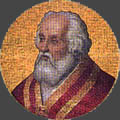 John XV
was a Roman, the son of a priest named Leo. At the time of his election John was
cardinal-priest of St. Vitalis. The only authentic fact about his election is
that it took place in August 985.
John XV
was a Roman, the son of a priest named Leo. At the time of his election John was
cardinal-priest of St. Vitalis. The only authentic fact about his election is
that it took place in August 985.
John XV was a learned man and a writer. He has been accused of
rank nepotism and grasping avarice, but the accusations are far from proved.
Indeed the poor man had little to say about civil government in Rome. A kinsman
of Prince Alberic II now repeated Alberic's seizure of civil power in Rome.
Crescentius of the Marble Horse, as he was called, was the son of that
Crescentius who had led the revolt against Benedict VI. Shortly after John's
election, Crescentius established himself as practically dictator in Rome. A
smooth politician, he even got along with the Empress Theophano when she visited
Rome in 989. Though John XV was limited in temporal power at Rome, he made his
influence felt in distant lands. His mediation was sought in a quarrel between
Ethelred the Unready, king of England, and Richard, duke of Normandy. Through
his legate Leo, the Pope succeeded in bringing about a peaceful settlement.
The most interesting case of Pope John's pontificate was the
fight over the archbishopric of Rheims in France. Hugh Capet, helped by
Archbishop Adalberon of Rheims and the monk, Gerbert, had finally supplanted the
Carolingian dynasty on the throne of France. The Carolingian Charles, duke of
Lorraine, invaded France in an attempt to dethrone Hugh. He captured Rheims and
its archbishop Arnulf. Now Arnulf was himself a Carolingian, and Hugh suspected
that Arnulf had sold out his king for his family. Hugh therefore asked Pope John
to depose Archbishop Arnulf. Before the Pope could answer, the tide of war swung
in favor of Hugh, and he drove Lorraine's forces out of Rheims and seized Arnulf.
The King then had a synod depose Arnulf and elect his friend and backer, the
monk Gerbert. Pope John did not allow this highhanded action to go without
rebuke. He ordered the French bishops to hold a free synod, which quashed the
deposition of Arnulf. The affair caused an outbreak of antipapal sentiments
among Gerbert's supporters. But in the end Gerbert had to go. John V canonized
Ulrich, the holy bishop of Augsburg on January 31, 993. He also granted numerous
privileges to various churches and monasteries.
In 995 the tyranny of the Patrician Crescentius so irked the
Pope that he fled to Tuscany and appealed to Emperor Otto III to put an end to
the Patrician's usurpation. Crescentius, ever more the diplomat than the
fighter, pleaded with the Pope to come back to Rome, and before the Emperor
arrived, John was once more back in the Lateran. While all eyes were turned on
the approaching Emperor, John XV was carried off by a fever in March or April,
996.
Excerpted from "Popes
Through the Ages" by Joseph Brusher, S.J.

